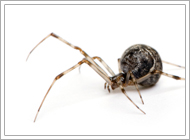American House Spider

The common house spider, sometimes called the American house spider, is an extremely common spider in North America and South America, as its name suggests. They build their tangled web in secluded locations, which can also house eggs contained in one or more spherical sacs. Their behavior on webs is quiet and efficient.
They are generally dull in appearance, with patterns consisting of brown shades for coloration, often giving a vague spotted appearance that is particularly noticeable on the legs. Their average body size is a quarter-inch (9 mm) long, but they can be an inch (2.5 cm) or more across with legs outspread. These traits combined allow the spiders to blend into the background and escape notice.
Like some other species of the family Theridiidae, P. tepidariorum shares a body shape and size that makes it similar to widow spiders, which have venom that is classified as potentially dangerous.
A male and female often share the same web for longer periods, and several females often build their webs in close proximity. However, several females will fight each other on an encounter. This species can live for more after a year after reaching maturity. Each egg sac contains from 100 to more than 400 eggs, with a single female producing up to 17 egg sacs. The hatchlings remain in the mother's web for several days.
The assassin spider Mimetus puritanus (Mimetidae), and various jumping spiders such as Phidippus variegatus or Metacyrba undata prey on this species. The assassin bug Stenolemus lanipes (Emesinae) feeds apparently exclusively on spiderlings of this species.
All of the above information came from Wikipedia, the free encyclopedia

